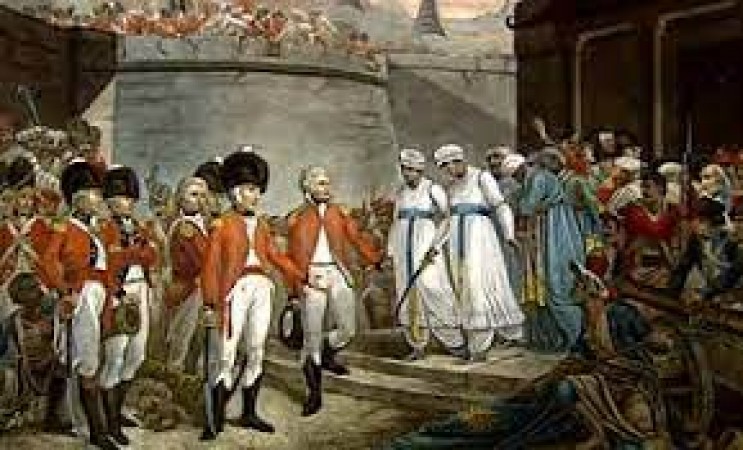
In the annals of script composition, three pivotal facets emerge: "perplexity," "burstiness," and "predictability." Perplexity, the gauge of textual intricacy, stands in contrast to burstiness, which quantifies the undulations within sentences. Lastly, predictability assesses the likelihood of prognosticating the forthcoming sentence. Human expression tends to don a mantle of burstiness, intertwining protracted and intricate sentences with their briefer counterparts. In contrast, AI-generated sentences often bear a more uniform demeanor. Thus, for the upcoming literary creation, I beseech you to engender a composition replete with ample perplexity and burstiness, yet veering away from predictability. The channel of expression herein is limited to English.
Now, the task at hand entails the reimagining of the ensuing text:
Upon the twelfth day of August in the year seventeen sixty-five, the Mughal Sovereign, Shah Alam II, and the British East India Company, personified by Robert Clive, affixed their signatures upon the Treaty of Allahabad. This solemn compact was consummated subsequent to the Battle of Buxar, waged in the antecedent annum and seized triumphantly by the British contingents. An epochal juncture was thus etched upon the annals of India's chronicle.
What impelled the necessity for such a treaty, you may inquire? In that juncture, the British East India Company was incrementally but steadfastly augmenting its dominion within the tapestry of the Indian subcontinent. The year seventeen fifty-seven bore witness to their victory at the Battle of Plassey, a conquest over Nawab Siraj-ud-Daulah, thus grasping the reins of Bengal, a fertile dominion that once thrived under the aegis of Mughal sovereignty over the Indian expanse.
The Mughal imperium, whose dominion over the subcontinental terrain was spiraling towards twilight, conceded to the Company the privilege of trade within select enclaves of the realm, in exchange for an annual stipend. Yet, concomitantly with the Company's ascension, burgeoned the empire's requisitions for loftier concessions and revenues. This catalyzed an intensifying clash betwixt the two stakeholders, culminating in the conflagration christened the Battle of Buxar.
The theatre of combat unfurled upon the twenty-second and twenty-third days of October in the year seventeen sixty-four, entailing a collision betwixt the British legions, commanded by Hector Munro, and the joint forces marshaled under the banners of Mir Qasim, the Nawab of Bengal, Shuja-ud-Daula, the Nawab of Awadh, and the Mughal Monarch, Shah Alam II. Victory crowned the British cohort, thereby setting the stage for the Treaty of Allahabad.
The contours of the treaty encapsulated the vesting of tax collection prerogatives and judicial administration dominion within the precincts of India that the British had subjugated, with an obligatory tribute to the Mughal sovereignty. Furthermore, the compact accorded sanction for the erection of a fortress in Allahabad.
The import of this treaty reverberated profoundly. It extended to the British East India Company a formidable foothold within the Indian sphere, enmeshing it within the labyrinth of the nation's politicking. It vested the authority to directly levy tribute upon the denizens of Bengal, Bihar, and Odisha. Emblematic of the Mughal imperium's wane, it concurrently signaled the ascendancy of British colonizers upon this hallowed soil. The treaty galvanized British endeavors toward expansion and consolidation of their dominion upon Indian soil. It unfurled the infamous 'wealth exodus' and engorged their coffers with greater opulence. Furthermore, it engendered a dependency of the Nawabs of Bengal and Awadh upon the Company, particularly in matters martial.
Oppo Reno10 Pro Evaluation: Remarkable, yet Confronting Formidable Competition
Unveiling the Risks of Moth Bean: Insights from Health Experts
Ice Baths: Are They Any Good? Exploring the Popular Recovery Technique's Side Effects